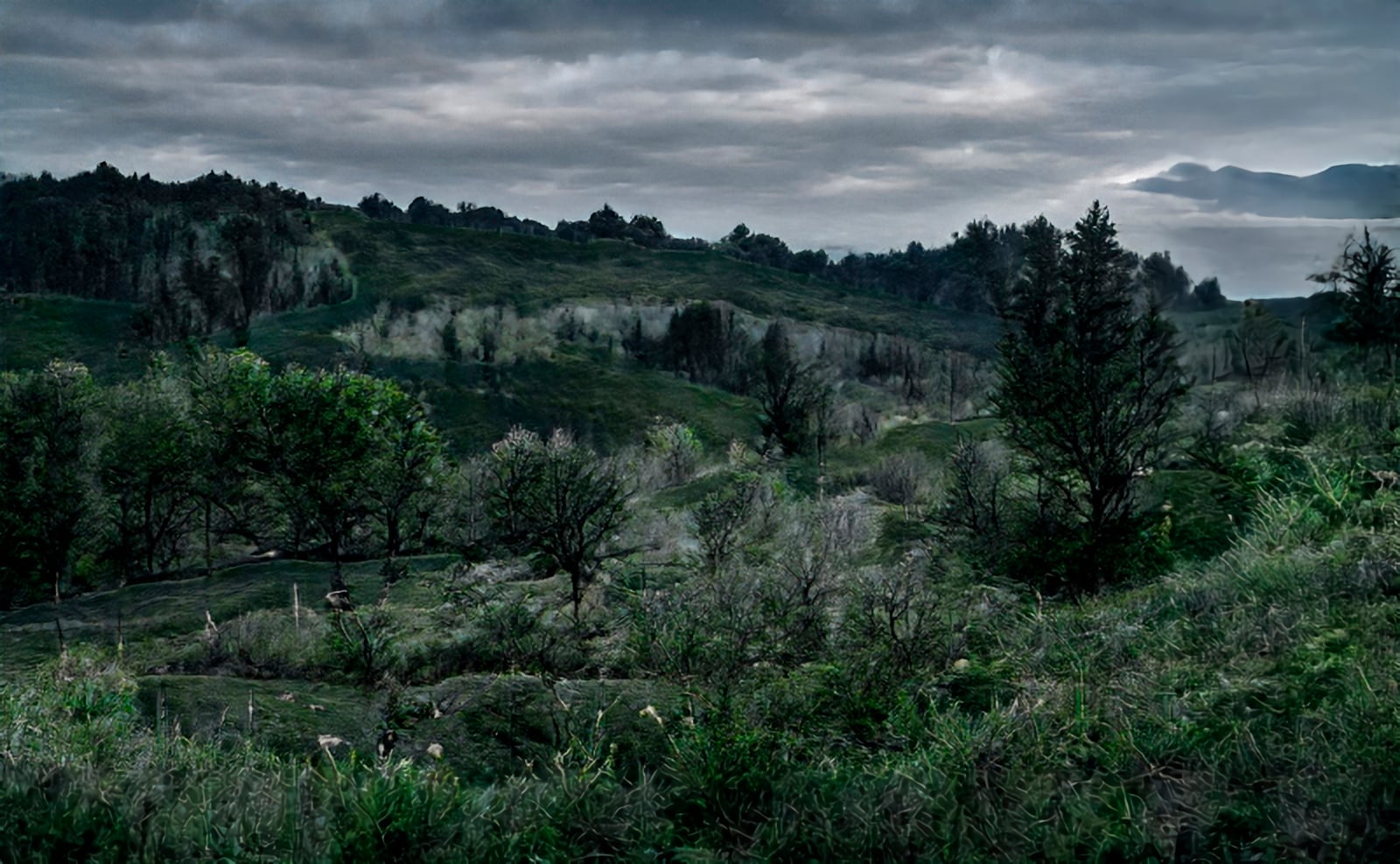 Dorota Gawęda and Eglė Kulbokaitė, MOUTHLESS Part I, 2020. Film stills.
Dorota Gawęda and Eglė Kulbokaitė, MOUTHLESS Part I, 2020. Film stills.
CHARACTERS
- AMADEUS VOGELSANG as:
-
Reader 1 is acting themselves here, a participant of the reading group, the voice can be casual and dry matter-of-fact unless otherwise stated.
-
Ghost 1 (Puszcza) Puszcza Białowieska - embodiment of the primeval forest which is the best preserved forest ecosystem and the last low-land deciduous and mixed old-growth forest in Europe. It is home to Europe’s largest bison population. One-third of the Polish part of the Białowieża Forest is protected as a national park and nature reserves (strictly protected areas), while the remaining two-third is subjected to forest management. Because of its unique value, Białowieża Forest has been designated as UNESCO World Heritage site and Natura 2000 site and is protected by the EU Birds and Habitats Directives. Despite this, in March 2016 the Polish Environment Minister decided to triple logging in the Białowieża Forest District. The ministry attempts to justify this intensification of logging with alleged need to tackle a bark beetle outbreak. Ghosts read in menacing whispers. Ghost 1 (Puszcza) reads especially slowly, taking breaks and weighing the words. Premonitious.
-
Guślarz/Koźlarz/Huslar Conjurer knows the spells to call the ghosts. The character refers to a performer of the Slavic and Lithuanian folk rite of Dziady (Forefathers’ Eve), summoning souls during a village gathering taking place at home, in cemeteries at the graves of the ancestors, or in places archetypal (and often also locally) associated with ancient worship centers - on hills, under sacred trees, in places considered to be sacred (sometimes in fact at the chapels, which were often built on ancient pagan worship places) or at the crossroads. The rite is presided over by Guślarz (Koźlarz, Huslar), who gives ritual formulas and recalls the souls of the dead. Guślarz/Koźlarz/Huslar - one who reads with passion, almost chanting. Voice strong, between pleading and commanding.
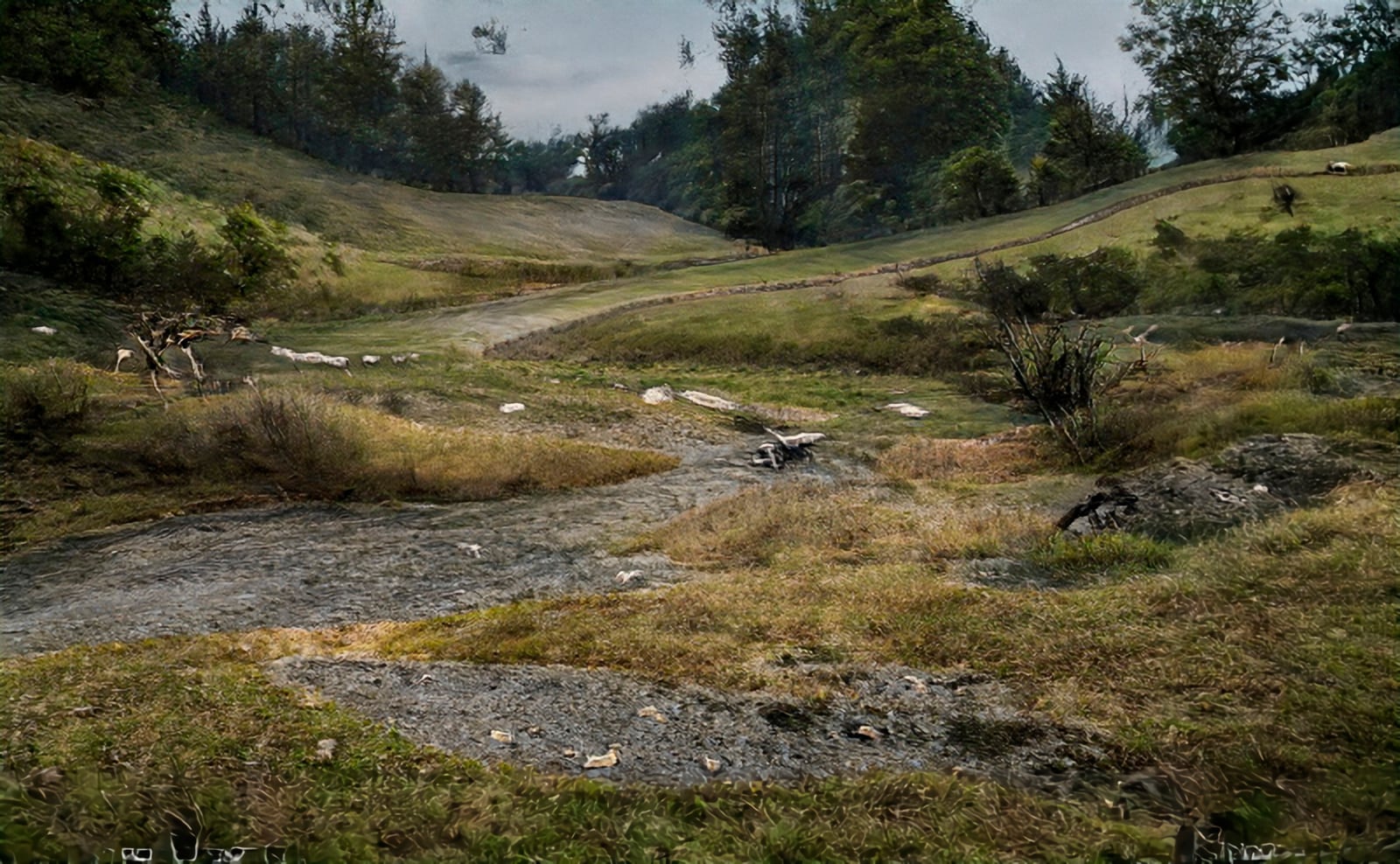 Dorota Gawęda and Eglė Kulbokaitė, MOUTHLESS Part I, 2020. Film stills.
Dorota Gawęda and Eglė Kulbokaitė, MOUTHLESS Part I, 2020. Film stills.
- AZUR ŠABIĆ as:
-
Reader 2 is acting themselves here, a participant of the reading group, the voice can be casual and dry matter-of-fact unless otherwise stated.
-
Ghost 2 (Barbli Bodmer of Wattenwyll) Accused of promiscuity and fornication with the devil in the forest. Under torture she confessed to the use of ointment, the making of a pact with the devil, the poisoning of water and apples, causing illness in humans and farm animals. Her trial and confession are rich in testimony of various people and graphic description of sexual acts with beasts and the devil. Executed for witchcraft in what is now the area of Canton Fribourg, CH, in 1637. Ghosts read in menacing whispers. Ghost 2 ( Barbli Bodmer) displays signs of madness. She reads her own interrogation record, the words put into her mouth by the accusers. She struggles reading, she stumbles over words. Her reading is disjointed. It becomes increasingly desperate as the accusation progresses.
-
Guślarz/Koźlarz/Huslar Conjurer knows the spells to call the ghosts. The character refers to a performer of the Slavic and Lithuanian folk rite of Dziady (Forefathers’ Eve), summoning souls during a village gathering taking place at home, in cemeteries at the graves of the ancestors, or in places archetypal (and often also locally) associated with ancient worship centers - on hills, under sacred trees, in places considered to be sacred (sometimes in fact at the chapels, which were often built on ancient pagan worship places) or at the crossroads. The rite is presided over by Guślarz (Koźlarz, Huslar), who gives ritual formulas and recalls the souls of the dead. Guślarz/Koźlarz/Huslar - one who reads with passion, almost chanting. Voice strong, between pleading and commanding.
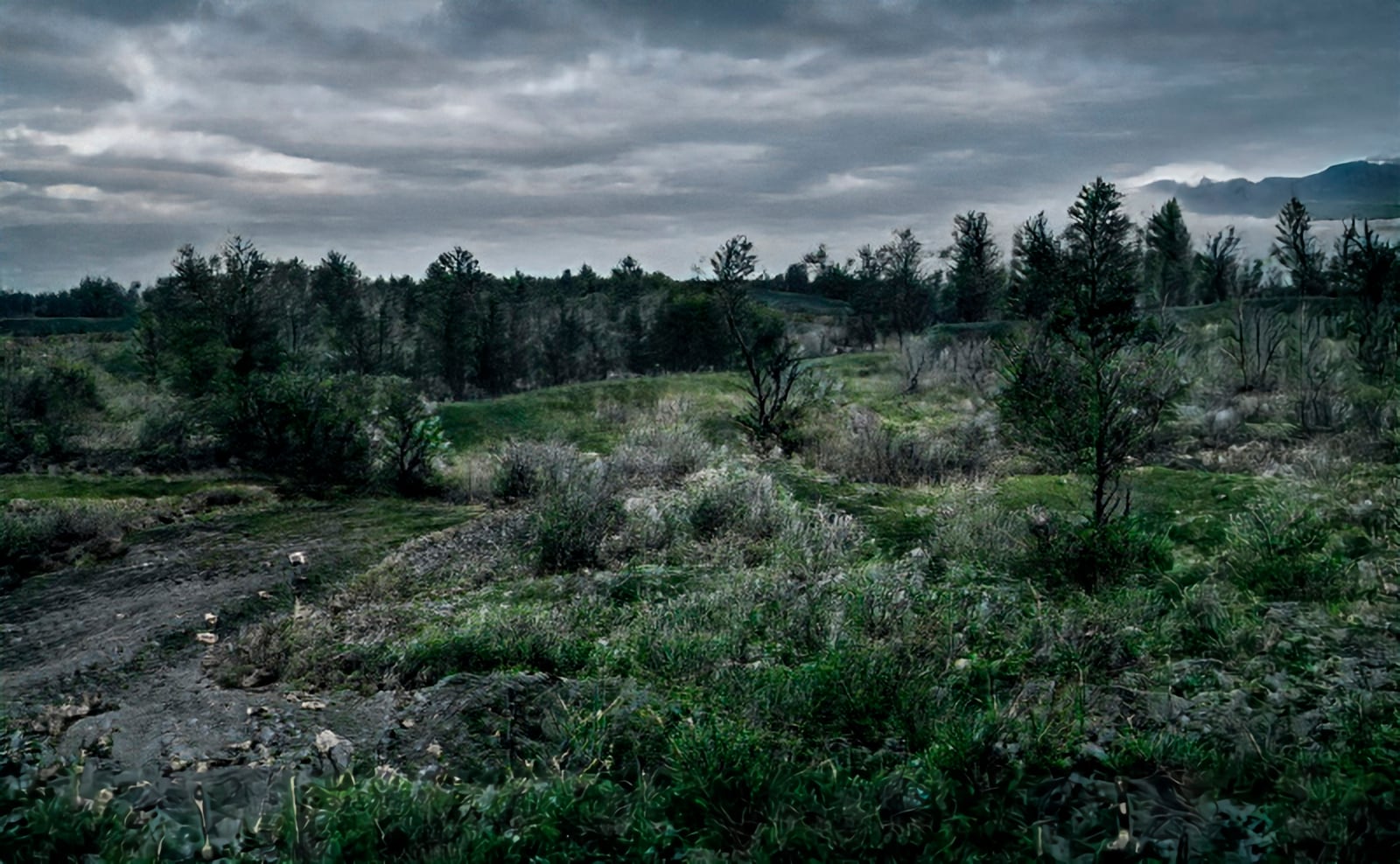 Dorota Gawęda and Eglė Kulbokaitė, MOUTHLESS Part I, 2020. Film stills.
Dorota Gawęda and Eglė Kulbokaitė, MOUTHLESS Part I, 2020. Film stills.
- JULIA MORITZ as
-
Reader 3is acting as themselves here, a participant of the reading group, the voice can be casual and dry matter-of-fact unless otherwise stated.
-
Ghost 3 (Catherine Quicquat of Vevey) Following the testimony of Jean Brunet, clerk and bourgeois of Vevey, Catherine Quicquat, of Vevey, appeared at the castle of La Tour – de – Peilz. She is defamed for heresy and denounced by several defendants. Her trial, instructed by the inquisitor Pierre d'Aulnay and the episcopal vicar Leonard de Bosco, began on March 15, 1448 and took place over four days. After three warnings, Faith Prosecutor Pierre Rondinel produced testimony and trial documents to strengthen the charge; he demanded the proclamation of the interlocutory sentence. After being tortured, Catherine Quicquat confesses to the inquisitor and denounces 13 people. The sentence is announced on March 18 in front of the church of Saint Martin de Vevey. She was executed for witchcraft in 1448. The trial of Catherine Quicquat, of Vevey is one of the first instances of the accusation of participating in the witches’ sabbath and sodomy. The sabbath is conceptualized after The errors of the Gazarli, or of those who move riding a broom or a stick - treatise published by unknown author/s circa 1430- 1440 in Savoy, Valais or Vaud. The text refers to the broom or stick that witches supposedly use to go to the Sabbath for the first time, theft being made possible after having previously coated the stick or broom with an ointment. Stick / broom and ointment are according to the manuscript given after a ceremony named not "sabbath" but "synagogue". Ghosts read in menacing whispers. Ghost 3 (Catherine Quicquat of Vevey) reads with conviction. She owns her heresy, revels in the morbid.
-
Guślarz/Koźlarz/Huslar Conjurer knows the spells to call the ghosts. The character refers to a performer of the Slavic and Lithuanian folk rite of Dziady (Forefathers’ Eve), summoning souls during a village gathering taking place at home, in cemeteries at the graves of the ancestors, or in places archetypal (and often also locally) associated with ancient worship centers - on hills, under sacred trees, in places considered to be sacred (sometimes in fact at the chapels, which were often built on ancient pagan worship places) or at the crossroads. The rite is presided over by Guślarz (Koźlarz, Huslar), who gives ritual formulas and recalls the souls of the dead. Guślarz/Koźlarz/Huslar - one who reads with passion, almost chanting. Voice strong, between pleading and commanding.
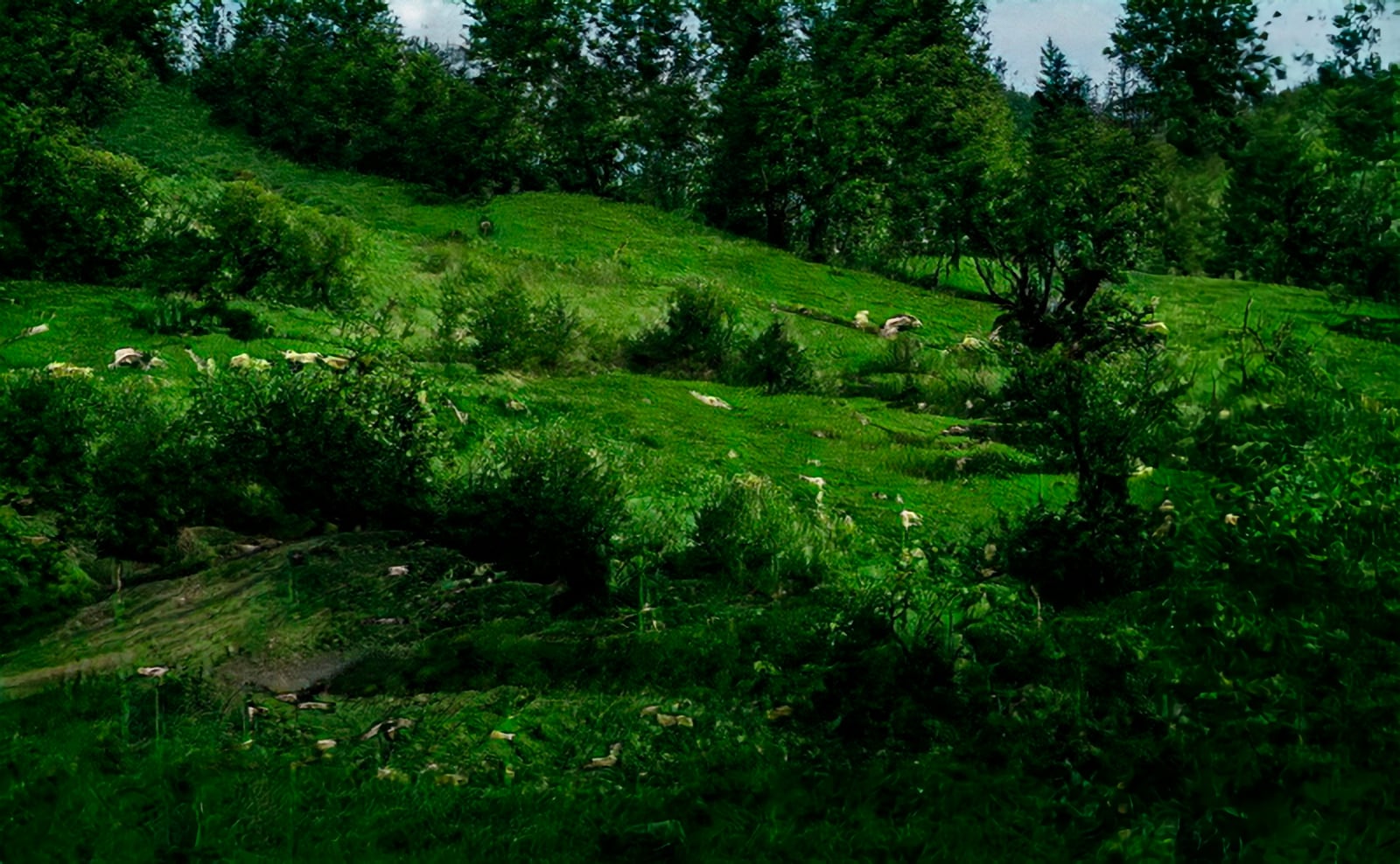 Dorota Gawęda and Eglė Kulbokaitė, MOUTHLESS Part I, 2020. Film stills.
Dorota Gawęda and Eglė Kulbokaitė, MOUTHLESS Part I, 2020. Film stills.
- NIKLAS DRAEGER as
-
Julia Moritz as Ghost 3 (Catherine Quicquat of Vevey) Following the testimony of Jean Brunet, clerk and bourgeois of Vevey, CH, Catherine Quicquat, of Vevey, appeared at the castle of La Tour – de – Peilz. She is defamed for heresy and denounced by several defendants. Her trial, instructed by the inquisitor Pierre d'Aulnay and the episcopal vicar Leonard de Bosco, began on March 15, 1448 and took place over four days. After three warnings, Faith Prosecutor Pierre Rondinel produced testimony and trial documents to strengthen the charge; he demanded the proclamation of the interlocutory sentence. After being tortured, Catherine Quicquat confesses to the inquisitor and denounces 13 people. The sentence is announced on March 18 in front of the church of Saint Martin de Vevey. The trial of Catherine Quicquat, of Vevey is one of the first instances of the accusation of participating in the witches’ sabbath. The sabbath is conceptualized after The errors of the Gazarli, or of those who move riding a broom or a stick - treatise published by unknown author/s circa 1430- 1440 in Savoy, Valais or Vaud. The text refers to the broom or stick that witches supposedly use to go to the Sabbath for the first time, theft being made possible after having previously coated the stick or broom with an ointment. Stick / broom and ointment are according to the manuscript given after a ceremony named not "sabbath" but "synagogue". Ghosts read in menacing whispers. Ghost 3 (Catherine Quicquat of Vevey) reads with conviction. She owns her heresy, revels in the morbid.
-
Mouthless In Greek and Roman mythology, the Mouthless - Astomi, also known as the Gangines, are an ancient legendary group of people who had no need to eat or drink anything at all. They survived by smelling apples and flowers. Megasthenes (and later Pliny the Elder quoting Megasthenes) mentioned these people in his Indica. Megasthenes located them at the mouth of the river Ganges. In his description, they had rough and hairy bodies and no mouths. When traveling, they would carry roots, flowers and apples to smell. They could die by smelling a strong, unpleasant smell. Mouthless reads slowly, gently but precisely and clearly.
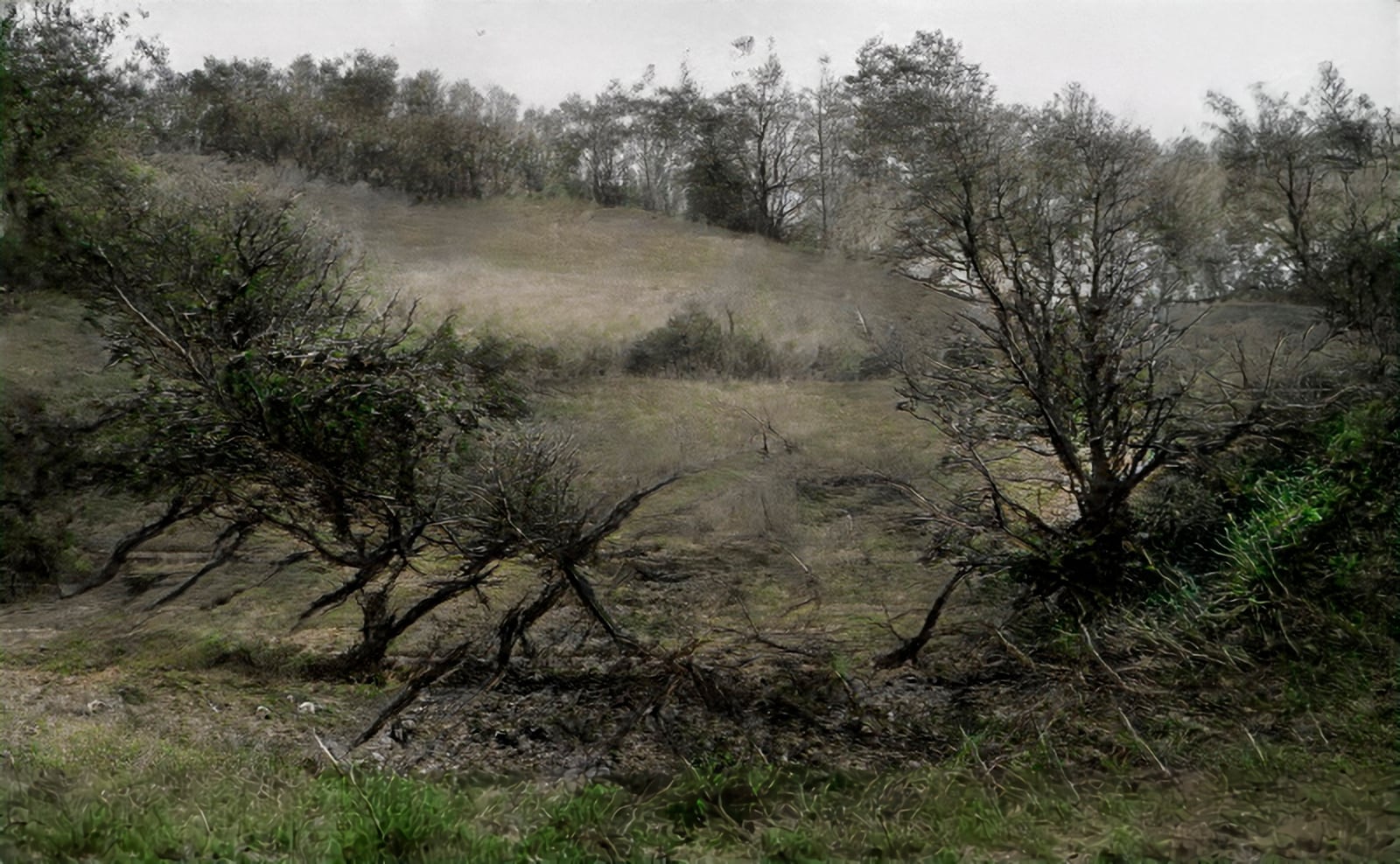 Dorota Gawęda and Eglė Kulbokaitė, MOUTHLESS Part I, 2020. Film stills.
Dorota Gawęda and Eglė Kulbokaitė, MOUTHLESS Part I, 2020. Film stills.
- LEILA HASSAN as
-
Amadeus Vogelsang as Ghost 1 (Puszcza) Puszcza Białowieska - embodiment of the primeval forest which is the best preserved forest ecosystem and the last low-land deciduous and mixed old-growth forest in Europe. It is home to Europe’s largest bison population. One-third of the Polish part of the Białowieża Forest is protected as a national park and nature reserves (strictly protected areas), while the remaining two-third is subjected to forest management. Because of its unique value, Białowieża Forest has been designated as UNESCO World Heritage site and Natura 2000 site and is protected by the EU Birds and Habitats Directives. Despite this, in March 2016 the Polish Environment Minister decided to triple logging in the Białowieża Forest District. The ministry attempts to justify this intensification of logging with alleged need to tackle a bark beetle outbreak. Ghosts read in menacing whispers. Ghost 1 ( Puszcza) reads especially slowly, taking breaks and weighing the words. Premonitious.
-
Ghost 5 (Tituba) - the Amerindian enslaved woman called Tituba who was among the first three persons to be accused of witchcraft in Salem, Massachusetts, in 1692. The other two—Sarah Osborne and Sarah Good—vehemently protested their innocence. But Tituba confessed and thereby gave the Salem magistrates reasons to suspect that the Devil's followers had invaded their midst. Nineteen people were subsequently hanged for witchcraft, one man was pressed to death, and close to two hundred were accused of witchcraft; over fifty of them confessed. Ghosts read in menacing whispers. Ghost 5 ( Tituba) reads with a strong, empowered voice. She possesses confidence in her knowledge and words.
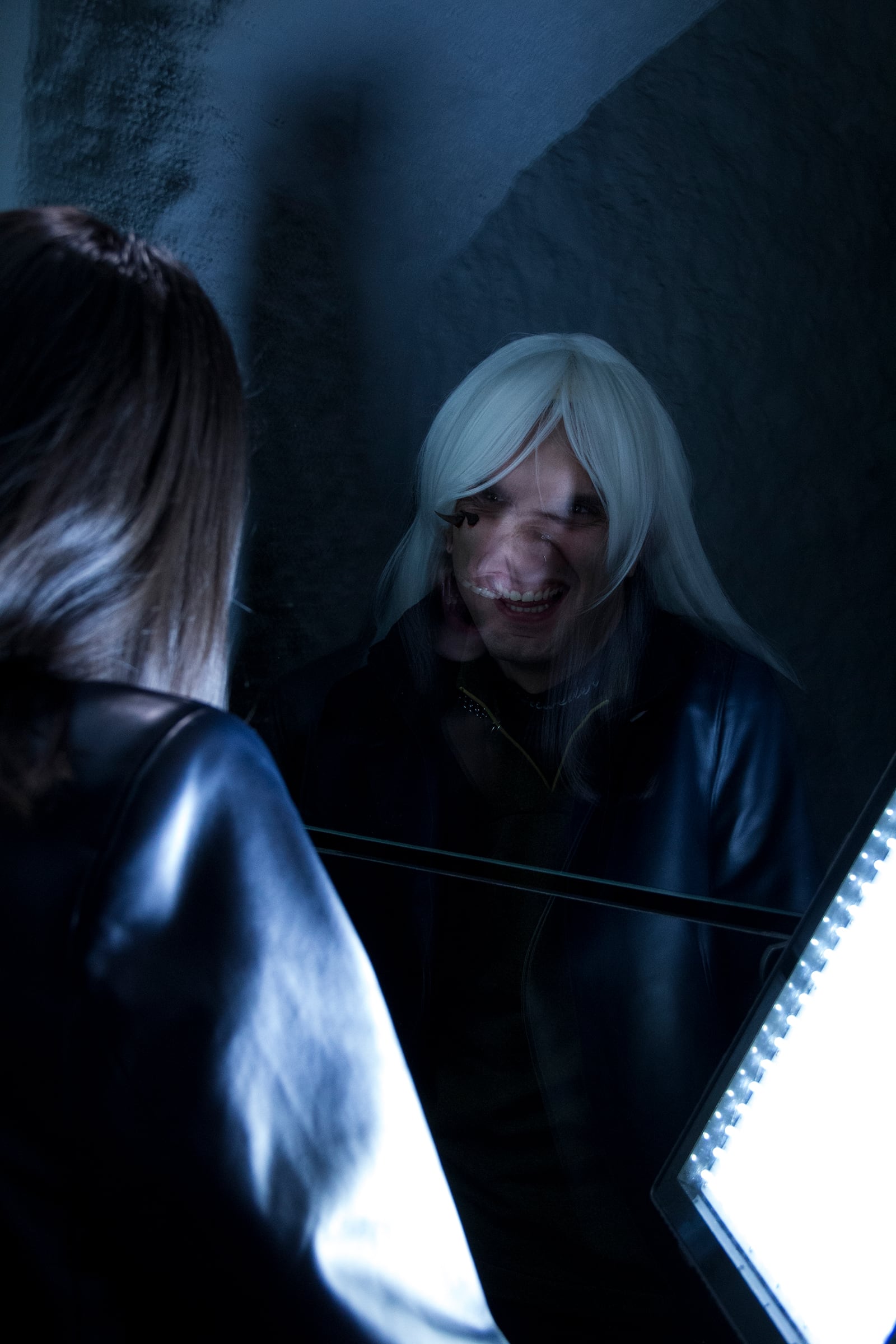 Dorota Gawęda and Eglė Kulbokaitė, Making of MOUTHLESS Part I, 2020.
Dorota Gawęda and Eglė Kulbokaitė, Making of MOUTHLESS Part I, 2020.
Azur Šabić as Ghost 2 (Barbli Bodmer of Wattenwyll) /struggles reading, she stumbles over words. Her reading is disjointed. It becomes increasingly desperate as the accusation progresses. The reading voice is of uneven tone, always changing. Conveys madness and desperation read as if frantic, overwhelmed, strong acting/
Barbli vorgemeldt ermant, die warheit zu reden, hatt bekennt, sy habe vor dryen jahren gott verlöugnet im graben der Felgen schewr. Daselbst habe sy einn warmen lufft gespirt unndt sye in ein ohnmacht gefallen.Zuvor habe sy in einnem zorn geschworren. Volgendts, da sy von diser schwachheit unndt abgang ihrer kräfften ein klein uffkommen sye, habe sy ein erschröckenli che stim gehört unndt von fernuß ein schwarzlecht hündli gesehen, so da bellete. Item eine grossen langen man, der sy gefragt, waß sy daselbst thue. Diser man sye gestalttet gsyn, samb hette er altte, zerrißne kleider. Sy habe sich gesegnet unndt er sich darvon gemacht. Daruff sye sy heimb gezogen unndt kranck gelegen. Uff die artikel deß examens er forschet, hatt bekennt, sy habe dem schnydern Veillard öpffel gäben, die sy mitt grüner salb angestrichen. Welliche salb ihren der böß geist gäben, namblichen daß er sy uff einnen stein in ihrem hauß gethan unndt sy dieselb dry mal daselbst gefunden. Der böß geist habe zu ihren gsagt, sy solle sich derselben gebrauchen in ihrer notturfft. Sy habe den bösen geist 3 mal in gemeldtem graben antroffen, er habe sy by dem lingken or geküßt unndt sy ihn ouch, er hab sy under dem lingken knew gezeichnet mit einnem pfründli, er heiße Hänßli. In einnem kyb habe sy Carle nachpures haußfrouwen böse geister gäben in byren. Das zeichen habe sy mitt gesegnetem anken vertryben wöllen, es sye aber noch ein löchli überbliben. Dem Petern Veillard habe sy zwey schwyn mitt ange salbeten schnizen verderbt. Vor dryen jahren habe sy Stephan Gaudrons khindt angeblaset, so gestorben sye halb jahr darnach. Des Keßlers uffm Brauch haußfrouwn uß kyb in schnizen böse geister gäben. Gegen gedachts Gaudrons magd geblasen, daß sy darab kranck worden sye. Sy bekennt, sy habe Gaudrons khindt uffgeholffen, aber allein daß Ave Maria uff ihm gebetten unndt das krytz gemacht. Der böß geist habe ihren zwey mal verbotten, un ser lieben frouwen meldung zu thun unndt so gottsdächtig zu syn. Sy habe Schufflers khindt kranck gemacht mitt eichlen, die sy zu vor im mundt gehabt. Der böß geist habe ihren bevolchen, böses zu thun. Sy habe mitt einnem stecken klein gutt verderbt, deren daß ein ihr, die andern Veillards waren. Sy habe gegen Tullins khindt, so gestorben ist, geblasen unndt ihn by der handt erwütscht. Wie ouch ein anders, so an dem arm erlamt ist. Sy habe m Wolffen bym Bernthor houßfrouwen dirre biren schnitz, brott, ziger gäben, darin sy züg gethan wie neßelsamen. Sy vermeinne, gedachte frow werde ihrem khindt ouch darvon gäben haben. Sy habe der grossen Clauda böse gei ster gäben in wasser, daß sy ihren zu trinken gab. Angedüttnen samen habe sy daheimb gefunden. Da sy den leutten böse geister gäben, habe sy sy angeblasen. Sy habe dem bösen geist gesagt, sy wölle ihr läben lang syn syn. Sy habe die bösen geister, idie sy den lütten gäben, hinder dem offen gfunden in einnem brieffli. Sy habe zwey mal mitt dem bösen geist unzucht getribenohne wollustj, er habe kaltte knew, ein kaltte rutten und fieß gehabt wie ein roß. Er habe sy zu dem end nider gefelt. Sy sye mitt ihrem meister in gedachts Veillards hauß by nächtlicher wyl gangen, er hab sy darinn getragen.Sy habe Petern zum Waldts haußfrouwen ein halben bazen umb bott lohn gäben, so mitt grüner salb angstrichen war. Erfragt, ob sy nitt des würts zu Tavers magd nammens Tichtli ein wehtumb angethan habe. Hatt zum bscheidt gäben nein. Einne, so man Tacconnary heißt, habe daß zugefügt, wie dan ihren gedachte Tichtli dasselbig an gezeigt. Bittet umb gnad.
ON SCREEN TEXT:
The Salem trials were also explained by the local authorities on this ground, with the argument that the New Englanders had settled in the land of the devil. As Cotton Mather wrote, years later, recalling the events in Salem:
I have met with some strange things . . . which have made me think
that this inexplicable war [i.e., the war made by the spirits of the invisible
world against the people of Salem] might have its origins among
the Indians whose chief sagamores are well known unto some of our
captive to have been horrid sorcerers and hellish conjurers and such
as conversed with the demons.
ON SCREEN TEXT:
It is significant, in this context, that the Salem trials were sparked by the divinations of a West Indian slave - Tituba - who was among the first to be arrested, and that the last execution of a witch, in an English-speaking territory, was that of a black slave, Sarah Bassett, killed in Bermuda in 1730. By the 18th century, in fact, the witch was becoming an African practitioner of obeah, a ritual that the planters feared and demonized as an incitement to rebellion.
Leila Hassan as Amadeus Vogelsang as Ghost 1 (Puszcza) / reads in whisper, menacing /
Virski drebule tu,
visais lapais drebėk.
Paukštis joks nenutūps,
prie tavęs nečiulbės.
Jums nelemta sūnai,
augt berneliais dailiais.
Jus užkeikiu nūnai-
virskit medžiais žaliais.
Ir vienodai tamsi,
vasarėlė, žiema,
mėlynam liūdesy,
rymosiu laukdama.
/ pause/
And when the ax came into the forest, the trees said: the handle is one of us.
Niklas Draeger as Julia Moritz as Ghost 3 (Catherine Quicquat, of Vevey) / reads in whisper, mysteriously, disjointed, slowly but with conviction with pauses/
In response to the frightening traumatic fragmentation of the coherent self, the idea of trauma provides explanatory narratives that, by offering one telling of how the subject achieved its ruination, support fantasies of an original time before the fall..
Leila Hassan as Amadeus Vogelsang as Ghost 1 (Puszcza) / reads in whisper, mysteriously, disjointed, slowly, with pauses, gradually growing and declining intensity/
Whereas the medieval economy had been based on organic and renewable energy sources—wood, water, and wind—the emerging capitalist economy taking shape over most of western Europe was based not only on the nonrenewable energy source—coal—but on an inorganic economic core—metals: iron, copper, silver, gold, tin, and mercury—the refining and processing of which ultimately depended on and further depleted the forests. Over the course of the sixteenth century, mining operations quadrupled as the trading of metals expanded. Large commercial banking organizations such as the Fugger Company of Augsburg owned and operated silver mines in Tyrol, gold mines in Silesia, mercury in Spain, copper in Hungary. The Fuggers had twenty-five different offices and made profits of up to 50 per cent on their investments, ten times greater than the Medicis, who in 1460, just a century before, had operated eight offices. The commercial bankers represented a high degree of capitalist organization and were extremely powerful. But, based on the mining industry, they ultimately depended on the forests for charcoal used in the smelting of ores. The metallurgical industries, which processed iron, lead, tin, and copper required enormous stretches of timber just to make one ton of charcoal. The prevalence of trees and wood influenced the location of the smelting and refining operations; it was cheaper to move the ore to the forest than vice versa.
ON SCREEN TEXT:
An integral part of the colonization process entailed the campaign waged by the Church to destroy indigenous religion. Although the clerics who accompanied the first conquistadors and administrators might have engaged in disputes over the nature of the indigenous soul, and over the theological justification of conquest, almost all agreed that the devil was flourishing in the Andes. How else to explain the devotion displayed by these people toward the hills, trees, stones, the sun, the moon, rivers and springs.
ON SCREEN TEXT:
Perhaps Christ or his disciples had not yet crossed the Atlantic, so the indios could not strictly speaking be accused of heresy; but certainly the devil had arrived. Indeed, not only the first Catholic evangelists, but the earliest Spanish conquerors and bureaucrats immediately felt the presence of Satan in the Andes, tempting and seducing the Indians into worshipping their huacas, their idols, their ancestors.
ON SCREEN TEXT :
Philippe Descola writes that among the Achuar, a population living in the upper part of Amazonia, "the necessary condition for effective gardening depends on direct, harmonious, and constant conunerce with Nunkui, the tutelary spirit of gardens". This is what every woman does by singing secret songs "from the heart" and magical incantations to the plants and herbs in her garden, urging them to grow.
ON SCREEN TEXT :
So intimate is the relation between a woman and the spirit protecting her garden that when she dies "her garden follows suit, for, with the exception of her unmarried daughter, no other woman would dare step into such a relationship that she had not herself initiated." As for the men, they are "therefore totally incapable of replacing their wives should the need arise .... When a man no longer has any woman (mother, wife, sister or daughter) to cultivate his garden and prepare his food, he has no choice but to kill himself" .
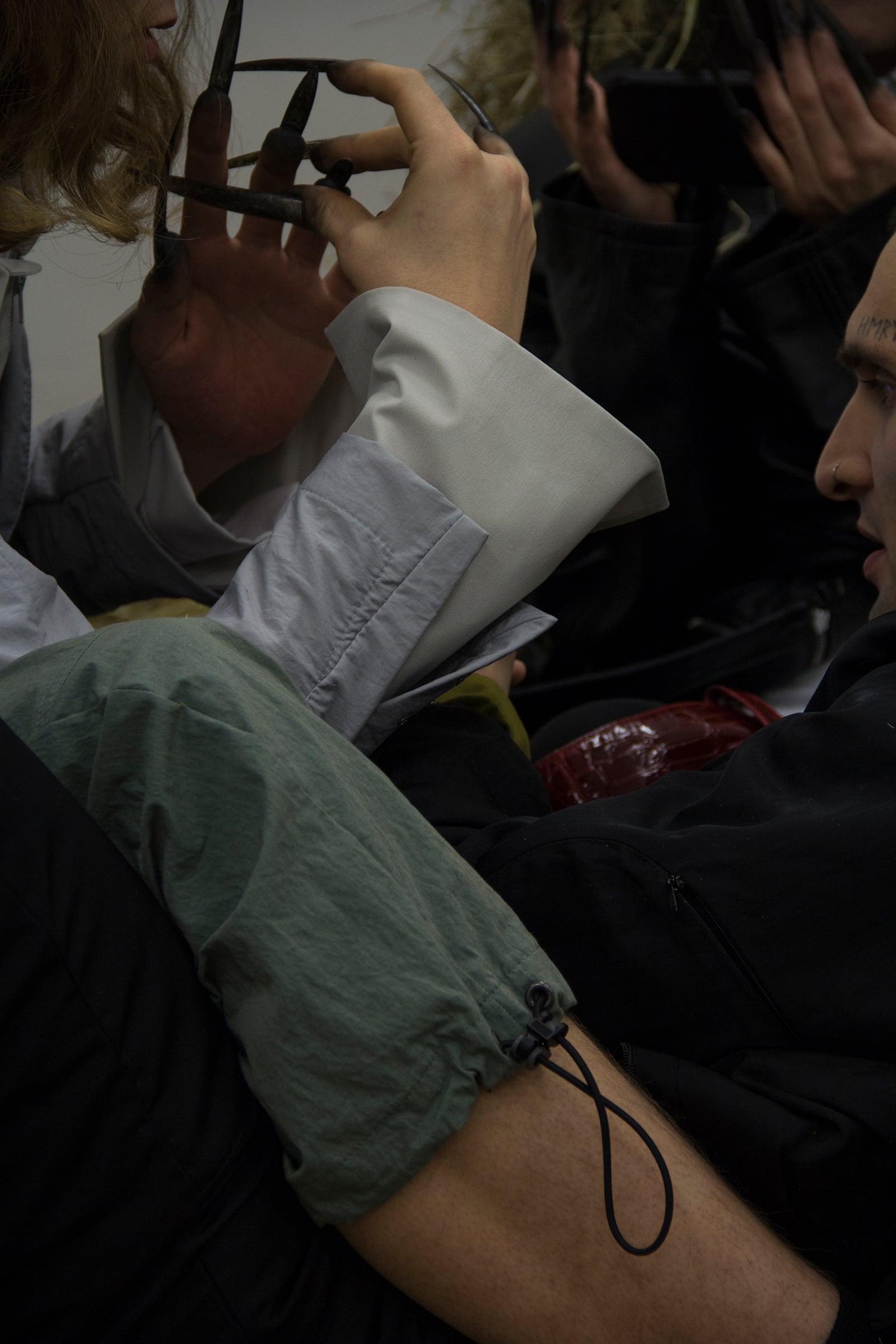 Dorota Gawęda and Eglė Kulbokaitė, Making of MOUTHLESS Part I, 2020.
Dorota Gawęda and Eglė Kulbokaitė, Making of MOUTHLESS Part I, 2020.
Niklas Draeger as Julia Moritz as Ghost 3 (Catherine Quicquat, of Vevey) / reads starting in whisper, mysteriously, disjointed, slowly, with pauses, voice breaking at times, desperate, growing derangement, strong acting /
The figures, who ought to appear one in front of the other, are piled up on top of each other, and the tapestry weaver’s horror vacui, the compulsion to fill every inch of the surface, destroys the ambient atmospheric space by crowding it with foliage and animals of every kind. Monkeys, slags, deer, pheasants, rabbits, even beasts of prey.
Côno Godin, suicide, burned body, Katharina, wife of Jean Coppelin, seigneury of Aigremont (Val d'Ormont), burned, Sůmy, von Rechthalten, Burned, Greda Büsen, Magd von Sůmy, from Rechthalten, burned, Itha Stucki, from Äschlenberg, burned, Peter Stucki (Sohn), from Äschlenberg, Anguilla Hortschina, Alix Buchser, burned, Antonia du Cloz, from Cugy, burned, Johanneta, widow of Etienne Lasne, burned, Gredi Collerey, former vagabond, from Avry-devant-Pont, "sentenced to be burned", Woman from Bendicht Spack, Büchslen, performed, Elsi Cochat, of Saint-Aubin, banned, Huguette Osalet, from Orbe, banned for life, Jean-François Borgognon, of Vesin, beheaded, Marguerite Grimaux, from Echarlens, burned alive, Jaquema Grimaux (daughter), from Echarlens, beheaded "at a young age", Jacques Grimaux (son), from Echarlens, released, François Sautier, decapitated, burned, Jenon Bardet, beheaded, burned, Suzanne Monnin, banned, Jean du Praz, old Catholic man, Bottens, decapitated, Jean Germond, from La Tour-de-Trême, sliced head, the body thrown into the flames……..
—a lion, a wolf, a leopard—
have gathered in the woods for purely decorative purposes. Indeed, the intensity of the scene is overwhelming, with humans, animals, and plants embedded in a highly processed forest environment.
Leila Hassan as Ghost 5 (Tituba) / reads in whisper, reads knowingly, confidently, strong/
We look back, we go behind; we conjure what is missing from the face. This backward glance is also an openness to the future, as the imperfect translation of what is behind us. Lines accumulate through repeated gestures, the lines that gather on skin, already take surprising forms.
The living dead, the dead living, the decaying living, those living slow deaths.
/pause/
Leila Hassan as Ghost 5 (Tituba) / reads in whisper, reads knowingly, confidently, strong/
Once or twice while wandering through the forest I met some of the villagers bending awkwardly over herbs and plants, their deceitful faces revealing the schemes in their hearts. I got great amusement from this. The art of doing evil is a complex one. If it is based on the knowledge of plants, this must be combined with the power to act on the unseen forces, which are rebellious by nature, transient as air, and need to be invoked.
/pause/
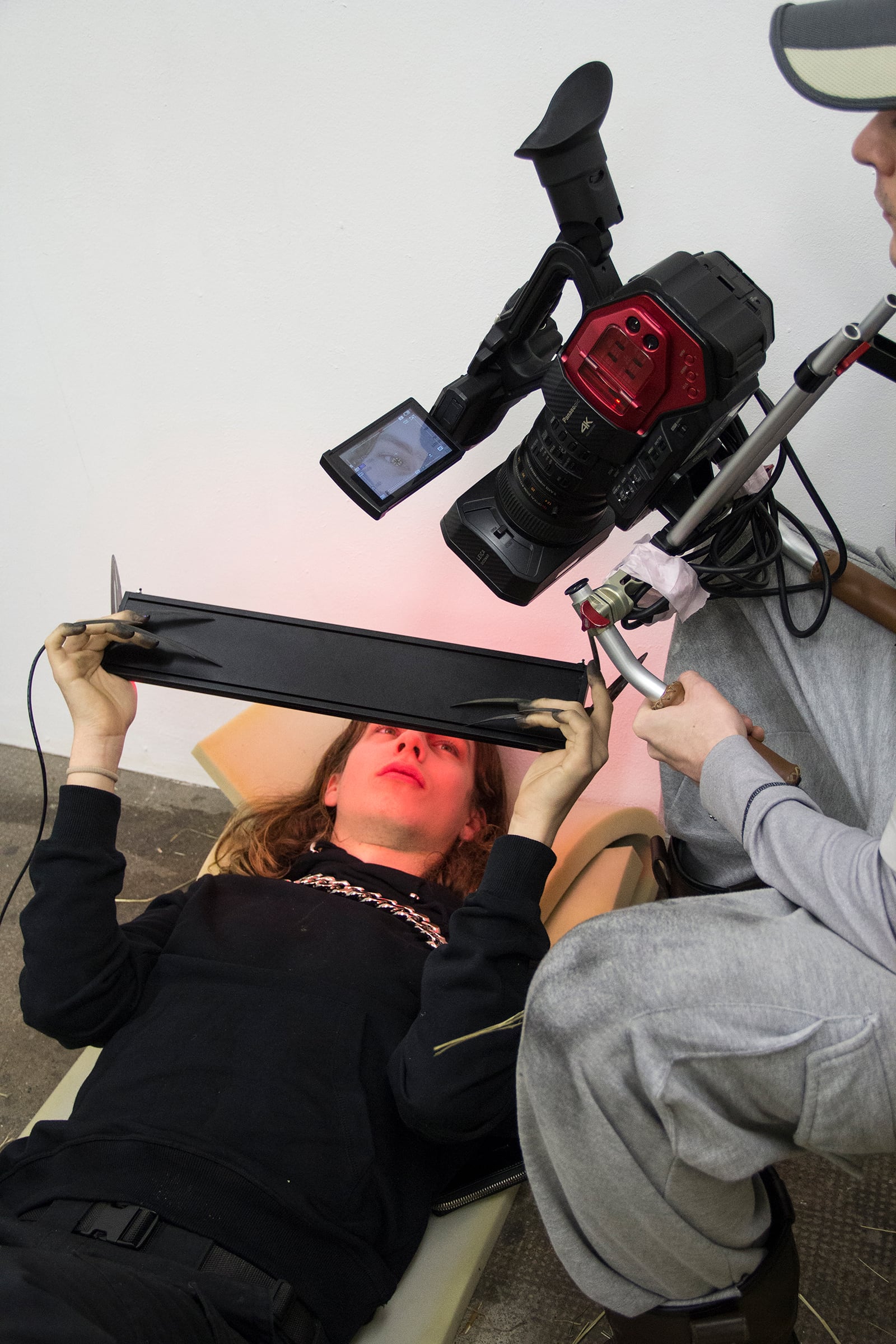 Dorota Gawęda and Eglė Kulbokaitė, Making of MOUTHLESS Part I, 2020.
Dorota Gawęda and Eglė Kulbokaitė, Making of MOUTHLESS Part I, 2020.
Leila Hassan as Ghost 1 (Puszcza) / reads in whisper, mysteriously, disjointed, slowly, with pauses. Premonitious. /
Emotion seemed to attach itself more particularly to the bushes, to these lengths and lengths of trees, crowding, so thickly growing there, swarming everywhere the eye could reach, pressing upon the river as though to suffocate it, standing in dense array, width after width beneath the sky, watching, waiting, listening.
_______________________________________________________
TEXTS QUOTED OR INDIRECTLY REFERRED TO (IN NO PARTICULAR ORDER):
The Word for World is Forest by Ursula K. Le Guin;
The Word for World is Still Forest ed. by Anna Sophie Springer and Etienne Turpin;
The Willows by Algemon Blackwood;
Six Theses on Plant Horror; or Why Are Plants Horrifying by Dawn Keetley;
Death by Landscape by Margaret Atwood;
Queer Ecology by Timothy Morton;
Queer Phenomenology by Sara Ahmed;
Weird and Eerie by Mark Fisher;
Dziady by Adam Mickiewicz;
Powers of Horror by Julia Kristeva;
Genderless Time by Paul B. Preciado;
Caliban and the Witch by Silvia Federici;
Skin Shows by Judith Halberstam;
Fribourg State Archival material;
The Mask: Remembering Slavery, Understanding Trauma by Grada Kilomba;
Slime Dynamics by Ben Woodwards;
Animacies by Mel Y. Chen;
Beautiful Data by Orit Halpern;
Wonders and the Order of Nature ed. by Lorraine Daston, Katharine Park;
Eglė žalčių karalienė by Salomėja Nėris;
Fledgling by Octavia Butler;
Disability and Pride by Eli Clare;
Living on a Damaged Planet ed. by Anna Tsing,
Heather Swanson, Elaine Gan, Nils Bubandt;
Mariola mirologi;
The Woodcutter and the Trees by Aesop.
The Death of Nature by Carolyn Merchant;
Museum Murten, CH, research;
I, Tituba, Black Witch of Salem by Maryse Condé (with introduction by Angela Y. Davis);
Tituba, Reluctant Witch of Salem by Elaine G. Breslaw;
Moon, Sun, and Witches by Irene Silverblatt;
Paranoid Reading and Reparative Reading, or, You’re So Paranoid, You Probably Think This Essay Is About You by Eve Kosofsky Sedgwick.